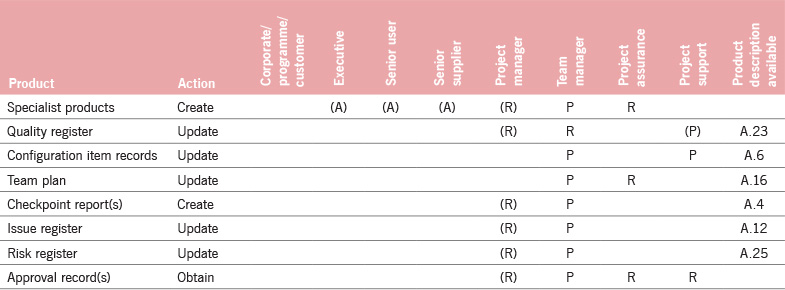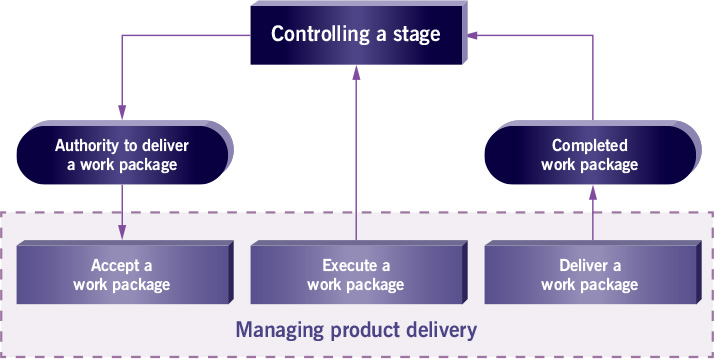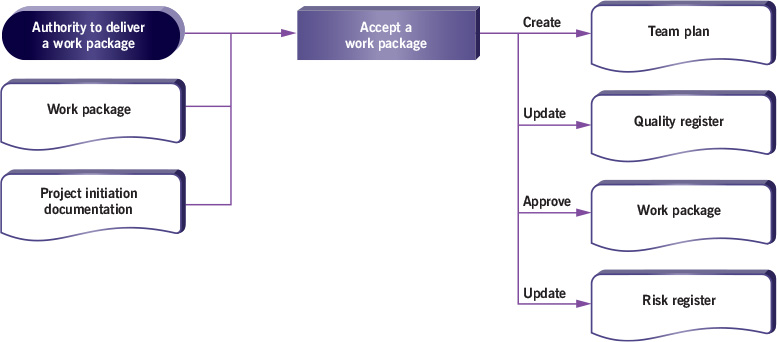18
Managing product delivery
This chapter covers:
•defining the team manager’s responsibilities
•producing a team plan to deliver the work package
•managing the execution and delivery of work packages
•guidelines for tailoring products and roles
18 Managing product delivery
The purpose of the managing product delivery process is to control the link between the project manager and the team manager(s), by agreeing the requirements for acceptance, execution and delivery.
The role of the team manager(s) is to coordinate an area of work that will deliver one or more of the project product’s components. They can be internal or external to the customer’s organization.
The objective of the managing product delivery process is to ensure that:
•work on products allocated to the team is authorized and agreed
•team managers, team members and suppliers are clear as to what is to be produced and what is the expected effort, cost or timescales
•the planned products are delivered to expectations and within tolerance
•accurate progress information is provided to the project manager at an agreed frequency to ensure that expectations are managed.
Figure 18.1 provides an overview of managing product delivery.
Managing product delivery views the project from the team manager’s perspective, whereas the controlling a stage process views it from the project manager’s perspective.
The team manager ensures that products are created and delivered by the team to the project by:
•accepting and checking authorized work packages from the project manager
•ensuring that interfaces identified in the work package are maintained
•creating a team plan for the work packages being assigned (this may be done in parallel with the project manager creating the stage plan for the management stage)
•ensuring that the products are developed in accordance with any development method(s) specified in the work package
•demonstrating that each product meets its quality criteria through the quality method(s) specified in the product description; this may include using the PRINCE2 quality review technique (see Chapter 8)
•obtaining approval for completed products from the authorities identified in the product description
•delivering the products to the project manager in accordance with any procedures specified in the work package.
If the project uses external suppliers that are not using PRINCE2, managing product delivery provides a statement of the required interface between the team manager and the PRINCE2 method being used in the project by the project manager. The work package may be part of a contractual agreement. Therefore, the formality of a team plan could vary from simply appending a schedule to the work package to creating a fully formed plan that is presented in a similar style to a stage plan.
The activities within the managing product delivery process are team manager oriented and are to:
•accept a work package
•execute a work package
•deliver a work package.
The fundamental principle is that before a work package is allocated to a team, there should be agreement between the project manager and the team manager as to what is to be delivered. This should cover the reporting requirements, what constraints apply, any procedures to be applied and whether the requirements of the work package are reasonable and can be achieved.
Figure 18.2 shows the inputs to, and outputs from, this activity.
PRINCE2 recommends the following actions:
•Review the work package:
•obtain any referenced documentation
•clarify with the project manager what is to be delivered
•negotiate with the project manager, on behalf of the team, the constraints within which the work is to be done
•agree tolerances for the work package
•understand the reporting requirements
•understand how, and from whom, approval for the product(s) is to be obtained
•understand how the approved product(s) is to be formally handed over
•confirm how the project manager is to be informed about the completion of the work package.
•Produce a team plan to show which product(s) can be completed within the given constraints (e.g. within the timebox when using an agile approach).
•Consult with project assurance (supplier) that the team plan is viable and in accordance with relevant supplier standards.
•Seek necessary approval for the team plan (although in a commercial customer/supplier relationship it may be inappropriate for the project manager to review and approve the team plan and, in such a context, the senior supplier may review and approve the team plans).
•Undertake a review of the risks against the team plan, and advise the project manager of any additional or modified risks (and, if the work package allows the team manager to directly log the risks, the team manager should update the risk register).
•Consult with project assurance as to whether any extra reviewers are required and ensure that the quality register is updated accordingly (check the work package for the procedure to update the quality register).
•Agree to deliver the work package.
Table 18.1 shows the responsibilities for this activity.
Table 18.1 Accept a work package: responsibilities

Key: P (producer) – responsible for product’s production; R (reviewer) – ideally independent of production; A (approver) – confirms approval.
The complete list of responsibilities for each product is shown. Where a product is produced, reviewed or approved in another process, the responsibility is shown in parentheses, as in (P), (R) or (A).
The work has to be executed and monitored to the requirements defined in the authorized work package.
While developing the products, the team manager should not exceed the work package tolerances agreed with the project manager. The team manager can only proceed with the work package or take corrective action while the work package is forecast to be completed within the tolerances set by the project manager. As soon as work package tolerances are forecast to be exceeded, the team manager should raise an issue to the project manager who will then decide upon a course of action.
Figure 18.3 shows the inputs to, and outputs from, this activity.
PRINCE2 recommends the following actions:
•Manage the development of the required products:
•develop the products required by the work package to the quality criteria defined in the product descriptions
•ensure that the work is conducted in accordance with the required techniques, processes and procedures specified in the work package
•maintain the development and operational and support interfaces as detailed in the work package
•check the work package for the procedure to update the quality register (e.g. to record completed quality management activities)
•capture and record the effort expended
•monitor and control any issues and risks associated with the work package and advise the project manager of their status.
•Notify the project manager of any new issues, risks or lessons. The project manager can then decide on an appropriate course of action.
•Take the action required by the project manager.
•Obtain approvals for completed products:
•check the work package and follow the method of obtaining and issuing approval records
•check the work package and follow the procedure to update any configuration item records, if used.
•Review and report the status of the work package to the project manager:
•determine the status of each product in the work package
•update the team plan and, if necessary, consult with project assurance (supplier) regarding its viability
•feed the progress information back to the project manager in checkpoint reports, in the manner and at the frequency defined in the work package
•if the agreed tolerances for the work package are forecast to be exceeded, notify the project manager by raising an issue.
Table 18.2 shows the responsibilities for this activity.
Table 18.2 Execute a work package: responsibilities

Key: P (producer) – responsible for product’s production; R (reviewer) – ideally independent of production; A (approver) – confirms approval.
The complete list of responsibilities for each product is shown. Where a product is produced, reviewed or approved in another process, the responsibility is shown in parentheses, as in (P), (R) or (A).
Just as the work package was accepted from the project manager, notification of its completion must be returned to the project manager.
Figure 18.4 shows the inputs to, and outputs from, this activity.
PRINCE2 recommends the following actions:
•Review the quality register to verify that all the quality activities associated with the work package are complete.
•Review the approval records to verify that all the products to be delivered by the work package are approved.
•Update the team plan to show that the work package is complete.
•Check the work package and follow the procedure to deliver the completed products.
•Notify the project manager that the work package is complete.
Table 18.3 shows the responsibilities for this activity.
Table 18.3 Deliver a work package: responsibilities

Key: P (producer) – responsible for product’s production; R (reviewer) – ideally independent of production; A (approver) – confirms approval.
The complete list of responsibilities for each product is shown. Where a product is produced, reviewed or approved in another process, the responsibility is shown in parentheses, as in (P), (R) or (A).
The activities in this process may be combined, split or run concurrently to suit the context, but care should be taken to ensure the integrity of the interface to the controlling a stage process.
As this process is where the specialist work is undertaken, work will be done using practices which are appropriate to the type of work. It is important that monitoring and control of specialist work is done using controls and measures which are appropriate to that work and that the project manager should incorporate them into the appropriate management products.
Work packages are not necessarily small in scale. All the PRINCE2 principles are as applicable to a work package as to a project, requiring appropriate governance and control and often needing a team manager who is skilled in project management. For large work packages, a team manager may create a hierarchy of smaller work packages to allocate to the team members. In this case the process for managing product delivery should be tailored to ensure the work in any lower-level work packages is controlled.
18.5.2 Tailoring products in managing product delivery
Table 18.4 provides tailoring guidelines for management products in managing product delivery.
Table 18.4 Guidelines for tailoring products in managing product delivery
Management product |
Tailoring guidelines |
Team plan |
The team plan may be a subset of the stage plan, and may be informal or formal, depending on the context. The team plan may include components in any format commensurate with the complexity of the work package, with views ranging from a simple list of accountabilities, products, activities and dates to Gantt charts. The plan may be held totally or partially within a planning tool(s). The team plan should be developed at the same time as the stage plan, not waiting for the work package; this will help ensure commitment and a well-integrated set of plans. In the accept a work package activity there would need to be a confirmation that the team plan is still valid. |
Checkpoint report |
Checkpoint reports may be informal or formal, depending on the context. If a project manager meets with the team managers regularly, then a verbal update, captured by the project manager in a daily log to be used to create the highlight report, may be sufficient. Additional information, such as KPIs, may be added if it helps understanding of progress. |
18.5.3 Tailoring roles in managing product delivery
A project manager may also undertake a team manager role.
The team manager is responsible for all activities but may be supported by team members. If a team manager is responsible for a lower-level work package, they may report to the higher-level team manager who is responsible for the next-higher-level work package.
Although the PRINCE2 processes define who creates, updates and approves a work package, these responsibilities may be changed provided both the team manager and project manager are in agreement on what the work package comprises.
18.5.4.1 Managing product delivery on a simple project
For simple projects, the nature of the specialist deliverables is likely to mean that controls can be light or informal (e.g. oral checkpoint reports recorded by the project manager in the daily log). Work packages are likely to comprise only a few specialist products.
If the project manager is also undertaking a team manager role, there may be no need for checkpoint reports. The project manager may, however, request individual team members to provide them. Checkpoint reports may be verbal and noted in a daily log by the project manager.
18.5.4.2 Managing product delivery when using an agile approach
Managing product delivery handles the important interface between the project manager and the delivery team, who will be working in an agile way. The interface would need to be collaborative and transparent where there is a collective agreement on what is to be produced and how this will be achieved (as opposed to a situation where instructions are given and followed). In agile working, delivery is done iteratively.
Progress information would be visible on an information radiator which is frequently updated by way of the daily activities of working in an agile way. This provides the information for the project manager to manage the project at the stage level by having clear and regular information across all the teams at the delivery level.

Tip
Retrospectives and Kanban boards can provide good progress information to feed into end stage and project closure reports.
18.5.4.3 Managing product delivery from a supplier perspective
From the supplier perspective, all its contracted work (to provide products) is likely to be managed as work packages within the customer’s project. Note, however, there may be times when a supplier is providing specialist services within work packages run by others or has part of its own work packages contracted to another supplier (subcontractor). The controls and reporting within the managing product delivery process should be reflected in the relevant supplier contracts to ensure the project manager has visibility of progress and quality.
18.5.4.4 Managing product delivery on a project within a programme
Because all work packages are managed by a team manager through a project manager, managing product delivery has no direct interface with programme management and is therefore free of any direct impact.




